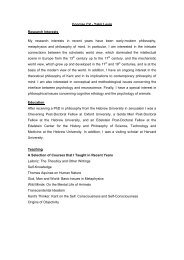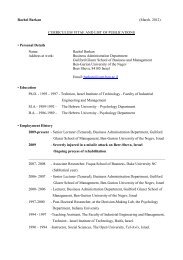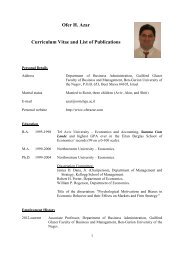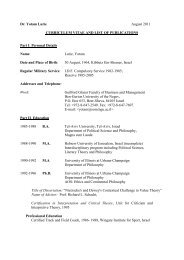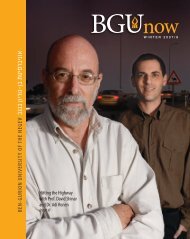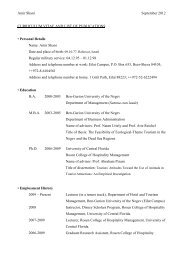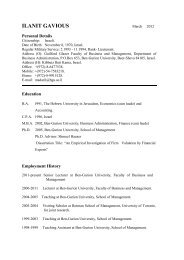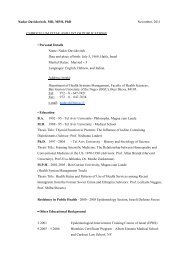Book of Abstracts
Book of Abstracts
Book of Abstracts
Create successful ePaper yourself
Turn your PDF publications into a flip-book with our unique Google optimized e-Paper software.
18<br />
single family farms in the Northern Negev, a sustainable advanced livestock farming system near Hura, and a<br />
planned farming community in Northern Kenya will be assessed by analyzing environmental indicators, such as<br />
energy consumption, greenhouse gas balance , soil conservation, eutrophication and water consumption. Our<br />
research indicates that incorporation <strong>of</strong> food and fodder trees is an essential step in improving the environmental<br />
balance <strong>of</strong> such systems. These trees also contribute to an improved economic balance by increasing fodder<br />
availability and providing high value non-forest products. On the other hand, the need for irrigation water can have<br />
severe environmental impacts due to the high energy cost <strong>of</strong> water pumping, transport or purification. The<br />
possibility to finance part <strong>of</strong> the investments required by means <strong>of</strong> carbon trading/CDM will be discussed, whereby<br />
current rules prevent any funding <strong>of</strong> small holder property and dryland forestry operations due to inadequate carbon<br />
legislation. Were the carbon sequestration potential <strong>of</strong> a 100 hectare dryland farm compensated in advance, the full<br />
costs <strong>of</strong> carbon neutral sustainable farming systems could be covered by a well-designed, carbon-based crediting<br />
system and would solve the world’s most acute food and energy problems in some <strong>of</strong> its poorest locations.<br />
Carbon cautious: Israel’s policies regarding afforestation and carbon sequestration<br />
Alon Tal; Chair, KKL Committee for Land Development (Overseeing Israeli Forestry); Blaustein Institutes for<br />
Desert Research, Ben Gurion University; Sede Boqer, Israeli; alontal@bgu.ac.il<br />
China was the first developing country, under the Kyoto Protocol, to receive carbon credits for a major tree planting<br />
project in the Pearl River Basin in Guangxi Province, meeting the somewhat convoluted documentation demands set<br />
forth by the U.N. Climate Change Convention. Moldova, Bangladesh, India and Uganda were soon to follow,<br />
receiving carbon credits for afforestation initiatives under the U.N. system that they could then sell to a developed<br />
“Annex 1” nation, according to the Kyoto Protocol. These projects were largely conducted in temperate regions.<br />
What is the potential <strong>of</strong> tree planting projects for generating pr<strong>of</strong>itable carbon credits in dryland regions? During<br />
the past 60 years, afforestation has transformed Israel’s landscape, with forests planted or and planned on 10% <strong>of</strong> the<br />
country’s land, much <strong>of</strong> it with less than 300 mm <strong>of</strong> annual precipitation. After early efforts to establish a<br />
successful commercial timber industry failed, recreation and ecosystem services came to dominate forestry policy<br />
objectives. Given Israel’s status as a ‘developing country’ under the Kyoto Protocol, forests’ economic potential<br />
through carbon sequestration was also explored, but did not prove to be compelling. Several considerations cooled<br />
the initial enthusiasm for seeking international carbon credits through afforestation. These include administrative<br />
obstacles associated with international accreditation (e.g., the small size <strong>of</strong> available land and the difficulty in<br />
proving “additionality”), low potential economic pr<strong>of</strong>itability, and ethical considerations. Rather, a voluntary<br />
<strong>of</strong>fsetting program was adopted, allowing donors to plant trees in Israel that balance individual carbon emissions.<br />
Afforestation in drylands does exhibit meaningful potential to counteract chronic carbon loss due to land<br />
degradation and deforestation. Trees planted in Israel’s semi-arid and arid regions exhibit surprisingly high carbon<br />
sequestration properties that are comparable to forests in temperate Europe. Based on this phenomenon, the<br />
potential for <strong>of</strong>fsetting may become a growing factor in dryland forestry policies, particularly once regulation <strong>of</strong><br />
CO2 emissions becomes more widespread and expected <strong>of</strong> dryland countries. Afforestation in degraded drylands, it<br />
is argued, produces considerable benefits, but the primary gain from “carbon sequestration” at present may not be<br />
economic, but rather the sense <strong>of</strong> satisfaction in contributing to critical international efforts to reduce the<br />
atmospheric concentration <strong>of</strong> green house gases.<br />
On-site sheep and goat manure digestion followed by Biogas production & aerobic composting.<br />
Yair Teller 1 , Tareqe Abu- Hamed 1 and Amit Gross 2<br />
1<br />
Center for Renewable Energy and Energy Conservation, The Arava Institute for Environmental Studies, Kibbutz<br />
Ketura, Eilot, Israel; yair@ecogas.co.il<br />
2<br />
Zuckerberg Institute for Water Research, Blaustein Institutes for Desert Research,<br />
Ben Gurion University <strong>of</strong> the Negev, Midreshet Ben Gurion, Israel<br />
In many rural areas, there is a need for decentralized waste management solutions.<br />
For example in the Negev Desert, there are about 90,000 Bedouins who live in unrecognized villages (i.e., no waste<br />
management infrastructure) and grow about 300,000 head <strong>of</strong> sheep, camels and goats which produce about 200<br />
tons <strong>of</strong> manure per day.



